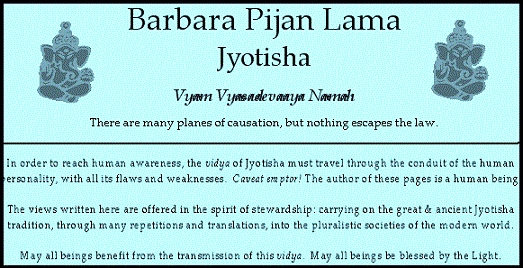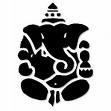|
Question: Guru drishti to Meena Surya-11
Q:
I am a one-year beginner in Jyotisha
and I am feeling a bit befuddled regarding how to do the first sort of significances. I know how to evaluate a chart in western astrology,
but Jyotisha seems to be more complicated.
My goal is to achieve an understanding of the karmic role of all the departments of life,
and to make predictions for myself and my family.
Can you give me a bit of direction? I really am trying here,
but just getting stuck with the multiple weightings.
For a
Urisha indriya-lagna, Guru = functional malefic but also a natural benefic. In fact,
brihaspati has four roles at least.
1. Natural Benefic
2. Functional Malefic
3.
Karaka (children)
4.
House significator
My question is:
-
when Guru (in this case) casts a graha drishti aspect,
say to Surya,
which of Guru roles are activated?
-
Is Surya getting the full spectrum of significations?
-
More specifically,
is the #2 influence only relevant when it applies to Surya's functional responsibilities?
-
Generally speaking,
in this combination,
if Surya is in Meena and
Guru-Vrishchika,
does Guru simultaneously cast an auspicious aspect to the Lord of the bhava for mother,
cast a
less benevolent aspect denoting potential destruction to mom?
-
while at the same time making Surya a child-producing graha and expanding Surya capacity to bring wealth? (Surya in 11th).
-
If so,
do we at this point go about seeking confluence for the various indications elsewhere in the chart in
varga s?
-
Or does a certain role minimize or cancel out altogether,
certain other roles for a particular graha for a specific lagna?
-
I haven't even mentioned Guru's effect as the 11th bhava-pati. Supposedly it is maleficent.
How?
-
It's bhava placement and drishti should be gainful and/or suggest areas while aspirations can be realized. Right?
-
Essentially,
ijust want to know what should immediately come to mind when I see a combination of Graha.
Which roles should take precedence or does it just depend?
A:first of all...
did you notice that your "question" is actually ten questions?
Many emails are received,
asking
for just a moment of your time and asking just one simple question.
When you yourself enter Jyotishavidya practice, you may encounter the same thing.
Doctors, lawyers,
and teachers get this sort
of simple enquiry constantly. The unaware querent is usually not trying to be deceptive.
Rather,
sheer ignorance of the world has minimized and oversimplified their understanding of the nature of the question.
Beware for your own practice boundaries too:the application of Jyotishavidya
priniples IS indeed a complex
and nuanced art!
OK,
now that the awareness of what you have requested = bit higher,
it is adjudged that the enquiry could benefit others. Let's see what could be offered in the way of an answer to the ten
simple questions : )
Here's what
might be done in a first assessment:
-
check: Karaka portfolio of graha
-
check: karaka functions of the bhava the graha occupy
-
check: friendship of these graha re: lagnesha
-
check: bhavapathi of the graha (4 lordships to consider = 2 from lagna + 2 from Chandra)
First and foremost keep the karaka significations in mind. Esperant Guru =
wisdom, expansion,
fertility,
optimism,
teaching,
priesthood.
These karaka characteristics are true regardless of rashi or bhava.
Urisha indriya-lagna: Guru is not a friend of Shukra lagnesha.
They compete for the same resources in the mind (time,
attention). Shukra wants to get pleasures, Guru wants to get wisdom.
However Guru occupies Vṛścika which = friendly rashi. So Guru is not impeded to express His own agenda of expansion and wisdom. Shukra might not like it,
but Guru has a fair amount of power including a drishti to lagna,
svakshetra 11,
Guru = randhresha-8 +
vriddhi-pati-11 from lagna.
What bhava does Guru rule from Chandra lagna?
As randhresha-8 +
vriddhi-pati-11 Brihaspati = specialist in esoteric knowledge and catastrophic,
transformative change (He is nice about it and always produces wisdom from it,
but Guru is nevertheless a dusthamsha pati)
Also as
vriddhi-pati-11 , He brings networks of friendship and networks of conceptual,
scientific,
philosophical knowledge.
He brings income from the marketplace of goods and ideas,
which everyone needs and appreciates.
-
But still, unless Guru would rule a trine house from Chandra lagna, He is not an agent of 'easy' experiences.
-
Trine lords bring forward credit from parallel lives . Unless a graha rules a trine,
its Vimshottari periods will consist mainly of correcting old mistakes from parallel lives or attempting challenging new movement on the path forward to merger with divine consciousness.
Much depends on Chandra in this assessment.
-
My first pass view would be that
Guru drishti to Meena Surya-11
will
expand the egoic-mind membrane and extend the aura.
This can be a good situation for a teacher (those for whom Guru activates the 10th navamsha) who might need to fill up a classroom or an auditorium with their charismatic presence. It might be less easy in a marriage where such a plus-sized egoic-mind membrane makes little room for the needs of the partner.
For example,
for the Mithuna lagna navamsha, Guru activates 7th and 10th navamsha,
defining both the spousal character and the professional leadership duties.
-
If incoming Guru drishti expands a good quality Surya in the radix,
the spouse will have a high confidence egoic-mind membrane and the native will deliver a resounding performance in center-stage
[Surya] settings. Generally,
the drishti from Guru to Surya = positive thing because these two graha are very good friends.
Guru wants wisdom and Surya wants to Light the Way toward merger with the divine.
They work well together unless they get tooooo close and Brihaspati gets
moudhya-dosha
"burned" by the rays of Surya.
Surya is in Meena therefore Ravi definitely benefits from
drishti from Ravi's Professor Guru. It is ALWAYS
beneficial for the purposes of the lord to cast His Eye into His own house! Landlords Naturally,
want to see into their own properties.
And,
for the Urisha indriya-lagna,
meena becomes labha bhava,
the house of
community development,
network s,
and the marketplace
. Social-progressive movements and political grassroots organizing get Guru-ized. Social community development should have a solid philosophical basis and the process of networking association = "each one teach one" .
Guru and Shani are neutrals so it is OK for a rashi of Guru to apply to 11.
Most importantly consider that Shani = friend of the lagnesha Shukra.
That understanding,
of
who is friends with whom,
will save you a lot of work in a first assessment.
If the nativity has a Shukra-ruled lagna,
then the houses of Shukra's friends Shani and Budha are going to be comfortable.
Chandra is friends with everybody.
So: 1, 2, 3, 5, 9, 10 are all good at the get-go.
-
And believe it or not,
conflict-ridden bhava-6 is often a good environment for the Vrishabha - Urisha native,
iF they choose to professionalize it with medicine,
teaching,
or law careers.
That is because Shani =
[Yogakaraka] for Vrishabha and Shukra-Shani are super-good friends.
Many of the best physicians in"social justice" [Tula] settings like public health clinics and social work environments have the Urisha indriya-lagna with a strong Shani.
-
But I digress (an occupational hazard of Jyotisha analysis!)
Guru's drishti to bandesha-4 Surya
can help to expand the mother's philosophical viewpoint. Urisha indriya-lagna usually has a somewhat direct,
confident,
and fashionable
[Surya] mother who needs to be center-stage.
-
If bandesha-4 occupies 11 for Urisha indriya-lagna,
the mother often is socially identified with a collective of some sort,
often those connected to each other via a shared belief system [Guru].
Within her social network,
she may be among the most outspoken and confident,
anatural center of attention.
-
Guru drishti won't hurt mom; it helps her expand her social connections and community development skills as well as her income,
because the
vriddhi-pati-11 casts drishti into 11. Benefits gains of income via salary,
rents,
royalties,
dividends etc.
Drishti of 8 is not harmful unless the person is superstitious.
If the Learner = of superstitious nature which is to say one believes that ultimate power resides in some force or being OUTSIDE of oneself,
then yes the drishti of randhresha-8 Guru will expand the fearful secrecy and self-destructive tendencies of
crisis-and-rebirth bhava-8.
-
This condition affects not only the masculine-nativity
[Surya] the mother (bandesha-4 = Surya) and the father * Surya
pitrikaraka
but also the entire collective into which they are interwoven by the great textile of their community and its belief system [Guru].
-
For most modern,
individualistic,
self-responsible people,
the randhresha-8 opens the doors to occult knowledge of spiritual empowerment which supplements and complements positivistic science on the one side and orthodox,
traditional teachings on the other side.
However yes a lower mind could suffer insecurity and destruction of true faith via fear-based beliefs in the destructive ultimacy of outside powers.
Consciousness makes or breaks the spiritual utility of any graha.
vriddhi-pati-11 is not a trine; that's why it is considered difficult.
But it is not a dushthamsha either,
meaning that 11 does not provide the setting for the most intense sorts of
pre-incarnationally planned payback.
Vriddhi-pati-11 and bhratru-pati-3 are not malefic; they are neutral by nature meaning one gets out of them what one puts into them within the brackets of the present incarnation.
Therefore whether 11 and vriddhi-pati-11 , 3 and bhratru-pati-3 swing toward easy or difficult,
smooth or challenging,
depends entirely on their lord.
BTW Vriddhi-pati-11 = svabhava of Shani; therefore 11 is predominantly concerned with social and material goals.
Spiritually motivated compassionate concerns for the betterment of others on the material plane,
for example providing medical clinics for impoverished children, = material target and thus indicated by 11.
Purely spiritual aspirations such as having a good death and staying in touch with the divine via prayer are more encompassed in 9 (ceremonial priesthood) and 12 (private prayer).
The varga cannot change any truth from the D-1 or D-9. Varga only confirm and fine-tune what exists in D-1 and D-9. Save the varga usage for intermediate learning stages.
Hope this is helpful for sorting out some of the basic approach to the // first pass
// assessment.
Wishing you best success in Jyotisha studies,
Sincerely, BP Lama, Jyotishavidya
|




 file update =
07-Jan-2026
file update =
07-Jan-2026
